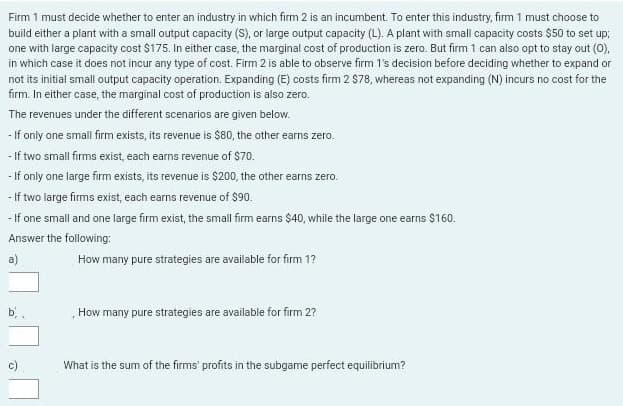Firm 1 must decide whether to enter an industry in which firm 2 is an incumbent. To enter this industry, firm 1 must choose to build either a plant with a small output capacity (S), or large output capacity (L). A plant with small capacity costs $50 to set up; one with large capacity cost $175. In either case, the marginal cost of production is zero. But firm 1 can also opt to stay out (0), in which case it does not incur any type of cost. Firm 2 is able to observe firm 1's decision before deciding whether to expand or not its initial small output capacity operation. Expanding (E) costs firm 2 S78, whereas not expanding (N) incurs no cost for the firm. In either case, the marginal cost of production is also zero. The revenues under the different scenarios are given below. - If only one small firm exists, its revenue is $80, the other earns zero. - If two small firms exist, each earns revenue of S70. - If only one large firm exists, its revenue is $200, the other earns zero. - If two large firms exist, each earns revenue of $90. - If one small and one large firm exist, the small firm earns $40, while the large one earns $160. Answer the following: a) How many pure strategies are available for firm 1? „How many pure strategies are available for firm 2? c) What is the sum of the firms' profits in the subgame perfect equilibrium?
Firm 1 must decide whether to enter an industry in which firm 2 is an incumbent. To enter this industry, firm 1 must choose to build either a plant with a small output capacity (S), or large output capacity (L). A plant with small capacity costs $50 to set up; one with large capacity cost $175. In either case, the marginal cost of production is zero. But firm 1 can also opt to stay out (0), in which case it does not incur any type of cost. Firm 2 is able to observe firm 1's decision before deciding whether to expand or not its initial small output capacity operation. Expanding (E) costs firm 2 S78, whereas not expanding (N) incurs no cost for the firm. In either case, the marginal cost of production is also zero. The revenues under the different scenarios are given below. - If only one small firm exists, its revenue is $80, the other earns zero. - If two small firms exist, each earns revenue of S70. - If only one large firm exists, its revenue is $200, the other earns zero. - If two large firms exist, each earns revenue of $90. - If one small and one large firm exist, the small firm earns $40, while the large one earns $160. Answer the following: a) How many pure strategies are available for firm 1? „How many pure strategies are available for firm 2? c) What is the sum of the firms' profits in the subgame perfect equilibrium?
Managerial Economics: A Problem Solving Approach
5th Edition
ISBN:9781337106665
Author:Luke M. Froeb, Brian T. McCann, Michael R. Ward, Mike Shor
Publisher:Luke M. Froeb, Brian T. McCann, Michael R. Ward, Mike Shor
Chapter17: Making Decisions With Uncertainty
Section: Chapter Questions
Problem 10MC: You are considering entry into a market in which there is currently only one producer (incumbent)....
Related questions
Question

Transcribed Image Text:Firm 1 must decide whether to enter an industry in which firm 2 is an incumbent. To enter this industry, firm 1 must choose to
build either a plant with a small output capacity (S), or large output capacity (L). A plant with small capacity costs $50 to set up;
one with large capacity cost $175. In either case, the marginal cost of production is zero. But firm 1 can also opt to stay out (0),
in which case it does not incur any type of cost. Firm 2 is able to observe firm 1's decision before deciding whether to expand or
not its initial small output capacity operation. Expanding (E) costs firm 2 S78, whereas not expanding (N) incurs no cost for the
firm. In either case, the marginal cost of production is also zero.
The revenues under the different scenarios are given below.
- If only one small firm exists, its revenue is $80, the other earns zero.
- If two small firms exist, each earns revenue of $70.
- If only one large firm exists, its revenue is $200, the other earns zero.
- If two large firms exist, each earns revenue of $90.
- If one small and one large firm exist, the small firm earns $40, while the large one earns $160.
Answer the following:
a)
How many pure strategies are available for firm 1?
b.
How many pure strategies are available for firm 2?
What is the sum of the firms' profits in the subgame perfect equilibrium?
Expert Solution
This question has been solved!
Explore an expertly crafted, step-by-step solution for a thorough understanding of key concepts.
Step by step
Solved in 4 steps with 1 images

Knowledge Booster
Learn more about
Need a deep-dive on the concept behind this application? Look no further. Learn more about this topic, economics and related others by exploring similar questions and additional content below.Recommended textbooks for you

Managerial Economics: A Problem Solving Approach
Economics
ISBN:
9781337106665
Author:
Luke M. Froeb, Brian T. McCann, Michael R. Ward, Mike Shor
Publisher:
Cengage Learning

Managerial Economics: A Problem Solving Approach
Economics
ISBN:
9781337106665
Author:
Luke M. Froeb, Brian T. McCann, Michael R. Ward, Mike Shor
Publisher:
Cengage Learning